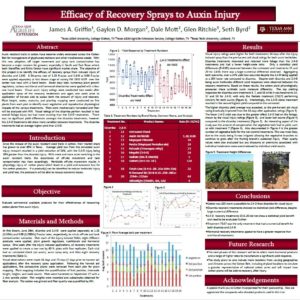I’ve received several calls this week requesting information on whether or not to keep injured cotton and management after the injury. In this brief article, I will cover the ‘keep or discard’ decision and briefly cover best management practices after the decision to keep the crop has been made. Depending on your situation, you may need to document the injury and/or keep a portion of the field to determine the yield penalty. That information is beyond the scope of this article but should be available from your insurance agent or attorney.
Should I keep the injured crop?
While we typically have a few farms of cotton following wheat, planting cotton in the middle of June is not for everyone. Subsequently, we are relatively limited in our decision making process at this time of the year; we are quickly approaching the point at which a replant is no longer an option and we must decide whether to keep the current injured stand or to replant it to soybeans. The size of the impacted area and logistics of splitting a field in different crops will definitely impact the decision, but the most important is estimating potential returns of the current crop versus the returns minus expenses of the alternative(s).
There have been several projects which attempt to characterize herbicide injury and, based on visual symptoms after injury, predict yield. Within a given herbicide, there are three main factors which influence the yield penalty relative to uninjured stands. These factors are 1) timing of the herbicide injury, 2) herbicide rate, and 3) remaining heat units in the season. Timing is typically the easiest factor to estimate. Rate is more challenging, but visual symptoms typically allow us to get within the ballpark. The factor which is nearly impossible to predict within a given year is the length of season. As an indeterminate, perennial crop, cotton has the potential to compensate through additional monopodial branching and fruiting bodies on sympodial branches. If we have a long fall, delays in fruiting due to herbicide injury may not cause substantial penalties. However, a shorter than normal fall will cut boll development short and cause substantial losses. Length of season is extremely important to those along the northern edge of the cotton belt, as we don’t have the length of season our friends to the south have.
The last point I’ll add on predicting the yield penalty- it is easy to over-estimate. I spoke with Dr. Randy Boman, retired Cotton Specialist out of Texas and Oklahoma, earlier this week about this very issue. In his words, injured cotton plants ‘know how old they are’ and should quickly move towards reproductive growth when they recover from the injury. I think this is a great point, and one of the reasons we watch the terminal after injury (particularly with auxins) to see if the herbicide has played-out. After new growth appears ‘clean’, normal growth should resume. Again, if provided with a favorable fall, yield penalties from light rates will be negligible.
It is very likely that your crop consultant, agronomist or county agent has experience with herbicide injury. Use these resources in predicting the yield penalty on impacted farms.
I’m keeping the stand. Now what?
The knee-jerk reaction to herbicide injury is almost always a foliar nutrient blend. Allow this urge to pass. Foliar fertilizers, while they can increase the nutrient concentrations within a plant, are most efficient when received by a healthy plant with a normal cuticle. Plants which have endured stress are going to be characterized by a reduced leaf area and typically will not have normal leaf structures. Subsequently, the efficiency of foliar nutrient applications will decline exponentially when applied to a stressed crop. If you are given the nutrient from your retailer, apply it to an adjacent field containing a healthy crop; it will have a better chance of increasing yields in that scenario.
Mr. James Griffin and Dr. Gaylon Morgan, Texas A&M graduate student and Texas Cotton Specialist, respectively, recently evaluated ‘recovery’ inputs which could be applied to a cotton crop after it was injured by an auxin. Their poster can be viewed by clicking the below image. I’d like to highlight a few important points within their conclusions. First, none of the evaluated inputs significantly increased yields. Second, the only numerical increase came from the application of IBA & Kinetin. Finally, following herbcide injury, ‘hormonal recovery treatments appeared to have greater responses than nutritional treatments.’ 
What should you do? Manage the crop conservatively. The return on investment within an injured acre will be less than a normal acre. Inputs should be applied at normal recommended rates to eliminate other stresses. Provide adequate fertilizer, eliminate drought stress when possible and protect fruiting bodies. Watch internode length to determine how much and when to apply plant growth regulators.
Take home:
- Use all resources to develop accurate yield estimates while keeping in mind it is easy to over-estimate the penalty associated with injury.
- If you decide to keep the crop, remember the most profitable approach will likely be conservative; eliminate/prevent stress as if you were managing a normal acre.
- Watch internode length to determine plant growth regulator rate and timing.



What trait does the injured cotton have – RR, Enlist, Extend, conventional?
What pesticide caused the injury? Enlist, Engenia, Roundup, Gramoxone, something else?
Was it caused by drift, volatilization, operator error?